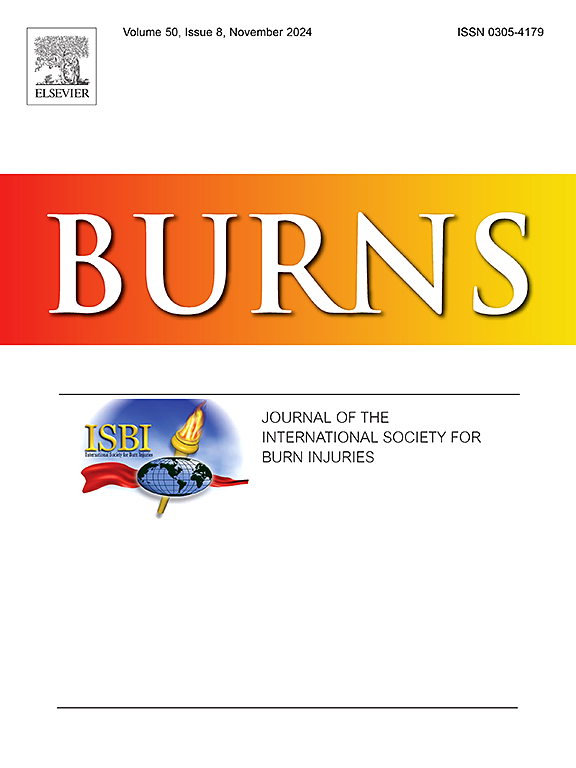烧伤患者心肌梗死的特征和预后:全国性分析。
IF 3.2
3区 医学
Q2 CRITICAL CARE MEDICINE
引用次数: 0
摘要
目的:研究烧伤患者心肌梗死(MI)的特征和预后:利用全国再入院数据库确定2016年至2020年烧伤患者的住院情况。主要结果是有心肌梗死和没有心肌梗死的烧伤患者之间全因住院死亡率的差异:在 200 130 例烧伤住院患者中,1997 例(1%)发生了急性心肌梗死。患有心肌梗死的烧伤患者年龄更大,更可能是男性,心血管风险因素的发生率更高。只有影响躯干和呼吸道的烧伤以及烧伤面积大于体表面积(BSA)20%的烧伤才会增加心肌梗死的风险。心肌梗死患者的全因院内死亡率较高(18.7% 对 3%,调整后的几率比 (aOR) 4.59,95% 置信区间 (CI) 3.66,5.76)。心肌梗死患者的心源性休克、室性心动过速和中风发生率更高。血管重建与较低的院内死亡率相关(aOR 0.33,95 % CI 0.17,0.64):烧伤患者的心肌梗死发生率较低,但死亡率和发病率较高。涉及躯干和呼吸道的烧伤以及烧伤面积大于 20% BSA 的烧伤患者发生心肌梗死的风险较高。血管重建与较低的院内死亡率有关。本文章由计算机程序翻译,如有差异,请以英文原文为准。
Characteristics and outcomes of myocardial infarction among burn patients: A nationwide analysis
Purpose
To examine the characteristics and outcomes of myocardial infarction (MI) among burn patients.
Materials and Methods
The Nationwide Readmissions Database was utilized to identify hospitalizations of patients with burns from 2016 to 2020. The main outcome was the difference in all-cause in-hospital mortality between burn patients with and without MI.
Results
Of 200,130 hospitalizations with burns, 1997 (1 %) developed acute MI. Burn patients with MI were older, more likely to be men, and had a higher prevalence of cardiovascular risk factors. Only burns affecting the trunk and respiratory tract, and those affecting > 20 % of body surface area (BSA), were associated with an increased risk of MI. All-cause in-hospital mortality was higher among patients with MI (18.7 % vs. 3 %, adjusted odds ratio (aOR) 4.59, 95 % confidence interval (CI) 3.66, 5.76). Cardiogenic shock, ventricular tachycardia, and stroke rates were higher among patients with MI. Revascularization was associated with lower in-hospital mortality (aOR 0.33, 95 % CI 0.17, 0.64)
Conclusions
The incidence of MI in burn patients is low but is associated with high mortality and morbidity. Burns involving the trunk and respiratory tract, and those affecting > 20 % BSA, were associated with an increased risk of MI. Revascularization was associated with lower in-hospital mortality.
求助全文
通过发布文献求助,成功后即可免费获取论文全文。
去求助
来源期刊

Burns
医学-皮肤病学
CiteScore
4.50
自引率
18.50%
发文量
304
审稿时长
72 days
期刊介绍:
Burns aims to foster the exchange of information among all engaged in preventing and treating the effects of burns. The journal focuses on clinical, scientific and social aspects of these injuries and covers the prevention of the injury, the epidemiology of such injuries and all aspects of treatment including development of new techniques and technologies and verification of existing ones. Regular features include clinical and scientific papers, state of the art reviews and descriptions of burn-care in practice.
Topics covered by Burns include: the effects of smoke on man and animals, their tissues and cells; the responses to and treatment of patients and animals with chemical injuries to the skin; the biological and clinical effects of cold injuries; surgical techniques which are, or may be relevant to the treatment of burned patients during the acute or reconstructive phase following injury; well controlled laboratory studies of the effectiveness of anti-microbial agents on infection and new materials on scarring and healing; inflammatory responses to injury, effectiveness of related agents and other compounds used to modify the physiological and cellular responses to the injury; experimental studies of burns and the outcome of burn wound healing; regenerative medicine concerning the skin.
 求助内容:
求助内容: 应助结果提醒方式:
应助结果提醒方式:


